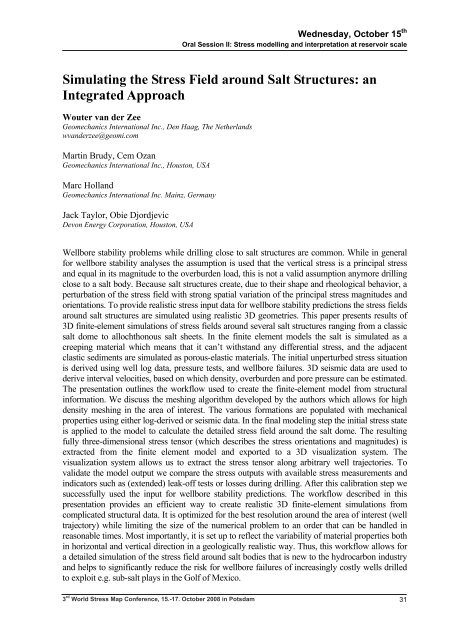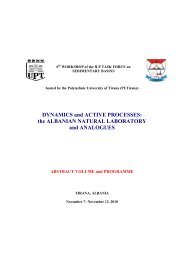World Stress Map Conference - International Lithosphere Program ...
World Stress Map Conference - International Lithosphere Program ...
World Stress Map Conference - International Lithosphere Program ...
You also want an ePaper? Increase the reach of your titles
YUMPU automatically turns print PDFs into web optimized ePapers that Google loves.
3 rd <strong>World</strong> <strong>Stress</strong> <strong>Map</strong> <strong>Conference</strong>, 15.-17. October 2008 in Potsdam<br />
Wednesday, October 15 th<br />
Oral Session II: <strong>Stress</strong> modelling and interpretation at reservoir scale<br />
Simulating the <strong>Stress</strong> Field around Salt Structures: an<br />
Integrated Approach<br />
Wouter van der Zee<br />
Geomechanics <strong>International</strong> Inc., Den Haag, The Netherlands<br />
wvanderzee@geomi.com<br />
Martin Brudy, Cem Ozan<br />
Geomechanics <strong>International</strong> Inc., Houston, USA<br />
Marc Holland<br />
Geomechanics <strong>International</strong> Inc. Mainz, Germany<br />
Jack Taylor, Obie Djordjevic<br />
Devon Energy Corporation, Houston, USA<br />
Wellbore stability problems while drilling close to salt structures are common. While in general<br />
for wellbore stability analyses the assumption is used that the vertical stress is a principal stress<br />
and equal in its magnitude to the overburden load, this is not a valid assumption anymore drilling<br />
close to a salt body. Because salt structures create, due to their shape and rheological behavior, a<br />
perturbation of the stress field with strong spatial variation of the principal stress magnitudes and<br />
orientations. To provide realistic stress input data for wellbore stability predictions the stress fields<br />
around salt structures are simulated using realistic 3D geometries. This paper presents results of<br />
3D finite-element simulations of stress fields around several salt structures ranging from a classic<br />
salt dome to allochthonous salt sheets. In the finite element models the salt is simulated as a<br />
creeping material which means that it can’t withstand any differential stress, and the adjacent<br />
clastic sediments are simulated as porous-elastic materials. The initial unperturbed stress situation<br />
is derived using well log data, pressure tests, and wellbore failures. 3D seismic data are used to<br />
derive interval velocities, based on which density, overburden and pore pressure can be estimated.<br />
The presentation outlines the workflow used to create the finite-element model from structural<br />
information. We discuss the meshing algorithm developed by the authors which allows for high<br />
density meshing in the area of interest. The various formations are populated with mechanical<br />
properties using either log-derived or seismic data. In the final modeling step the initial stress state<br />
is applied to the model to calculate the detailed stress field around the salt dome. The resulting<br />
fully three-dimensional stress tensor (which describes the stress orientations and magnitudes) is<br />
extracted from the finite element model and exported to a 3D visualization system. The<br />
visualization system allows us to extract the stress tensor along arbitrary well trajectories. To<br />
validate the model output we compare the stress outputs with available stress measurements and<br />
indicators such as (extended) leak-off tests or losses during drilling. After this calibration step we<br />
successfully used the input for wellbore stability predictions. The workflow described in this<br />
presentation provides an efficient way to create realistic 3D finite-element simulations from<br />
complicated structural data. It is optimized for the best resolution around the area of interest (well<br />
trajectory) while limiting the size of the numerical problem to an order that can be handled in<br />
reasonable times. Most importantly, it is set up to reflect the variability of material properties both<br />
in horizontal and vertical direction in a geologically realistic way. Thus, this workflow allows for<br />
a detailed simulation of the stress field around salt bodies that is new to the hydrocarbon industry<br />
and helps to significantly reduce the risk for wellbore failures of increasingly costly wells drilled<br />
to exploit e.g. sub-salt plays in the Golf of Mexico.<br />
31




